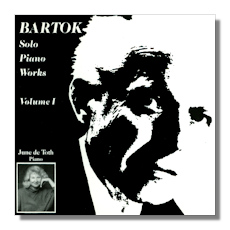
The Internet's Premier Classical Music Source
Related Links
- Bartók Reviews
- Latest Reviews
- More Reviews
-
By Composer
-
Collections
DVD & Blu-ray
Books
Concert Reviews
Articles/Interviews
Software
Audio
Search Amazon
Recommended Links
Site News
 CD Review
CD Review
Béla Bartók

Solo Piano Works, Volume I
- Seven Sketches
- Sonata 1926
- Fifteeen Hungarian Peasant Songs and Dances
- Four Dirges
- Allegro Barbaro
June de Toth, piano
Eroica JDT-30000 DDD 1993 50:19


Solo Piano Works, Volume II
- Suite, Op. 14
- For Children "42 Hungarian Folk Songs"
- Three Burlesques, Op. 8c
June de Toth, piano
Eroica JDT-3002 DDD 1995 60:56
The solo piano music of Hungarian composer Béla Bartók (1881-1945) will probably never make the top ten of all-time favorite classical music. Although performers I've met have a great respect for the small scale works of Bartók which they perform, and appreciate their impact upon 20th century classical music, to the average listener, this composer is known primarily through his famous Concerto for Orchestra of 1943. This lack of investigation of Bartók's main output (including the excellent string quartets, piano and violin concertos, and solo piano music) may be due to the music's perceived "strangeness" by the average listener. Bartók's penchant for melodies based upon pentatonic scales, plus his use of minor intervals and dissonance might be responsible for some degree of alienation.
In the composer's defense, however, his solo piano works represent a yielding excursion for the inquiring listener. Though Bartók's musical panorama frequently throbs with a barbaric pulse, there are moments of naïveté and innocence, simple and quiet reflection, as well as rare beauty. In these two Eroica discs, which preserve performances by the only female artist that I know of currently recording Bartók, we are provided an excellent manifestation of the composer's imagination. Volume one includes Bartók's Seven Sketches, Sonata 1926, Fifteen Hungarian Peasant Songs and Dances, Four Dirges, and Allegro Barbaro, while the second volume contains Suite, Op. 14, Forty-two Hungarian Folksongs, and Three Burlesques.
Hungarian-American pianist June de Toth, who studied with Gulda and Firkušný, confesses a spiritual affinity to Bartók, and her sympathetic approach offers a pleasing and successful tribute to a composer famous for incorporating folk material into his compositions. Bartók didn't merely visit the peasants and gypsies for musical inspiration; he took his shoes off, rolled up his sleeves, and "got dirty" to the point where he didn't want to return home. In her interpretations, de Toth reveals the "earthiness" of much of this music, as well as its secret personality.
Consider de Toth's handling of the Poco Lento on track seventeen of volume one. Without resorting to the headlong savagery favored by some pianists, de Toth is nonetheless uncannily good at creating the bell-like chords (reminiscent of Rachmaninoff's c# Minor Prélude) so crucial to the powerful development of the image of this miniature tone poem. Bartók was a master of rhythm and vitality, and mixed them well in a 20th century blender to concoct his catchy folk tunes and dances. Pianist de Toth herself proves to be an artful combiner, measuring requisite proportions of color, warmth, and energy in these pieces. The Three Burlesques falls strangely on the ear coming after the folksongs, yet de Toth is compelling here, as well as in the spell-casting episodes called Four Dirges. The pianist seemed to add a lyrical turn now and then to the weight and elemental drive of the Sonata, which I found contributed to the ambivalence of the piece. De Toth's shaping of the Sonata, one of this century's masterpieces for piano, offers an interesting alternative to the highly recommended versions recorded by Kocsis, Arrau and Richter. The Seven Sketches are brief and personal portraits, which de Toth characterizes with idiomatic phrasing and subtle shading. The third portrait alone is worth the price of the disc, owing to its ripe musicality. The digital sound quality of each disc is rather close, yet very fine.
To conclude, these two Eroica discs deliver a balanced view of a composer who could define subtle musical mysteries as easily as he could head-banging primitivism. That variety of expression, being so finely conceived initially by Bartók and interpreted with insight and compassion by pianist de Toth, should offer grounds for deeper exploration and appreciation of Bartók by the general listener. Recommended.
Copyright © 1996, Peter S. Murano



















